Fish living in the African lake Malawi survive in rather difficult conditions: food resources are scarce, and competition is very high. This led to the formation of various behavioral characteristics, primarily, pronounced territoriality. Fish that have occupied some territory will guard it to the last and often attack enemies that exceed them in size. This is how a small, but very beautiful Malawian cichlid, the pseudotrophyus Demasoni, does. It is about her that will be discussed in our article.
General information
Pseudotrofeus Demoni (Chindongo demasoni) is a freshwater ray-finned fish from the Tsichlov family. For the first time, the species was described not so long ago – in 1994 – by the researcher Ed Conings, who named the fish after his best friend L. Demason. The fish was originally assigned to the genus Pseudotrofeus, but a major systematic revision based on the latest scientific evidence resulted in the cichlid entering the Chindongo genus in 2016. This cichlid belongs to the Mbuna group, which translates as “inhabitants of the rocks” since the life of pseudotrophies is closely connected with the rocky shores of Lake Malawi. Here they find refuge and food for themselves, scraping algal growths from stones.
Pseudotrofeus Demasoni belongs to miniature cichlids, but despite its small size, the fish is one of the most territorial in its group. She is sometimes not embarrassed even by the superior size of the enemy: if he dared to invade the possession of the pseudotrophy, then he will certainly be attacked.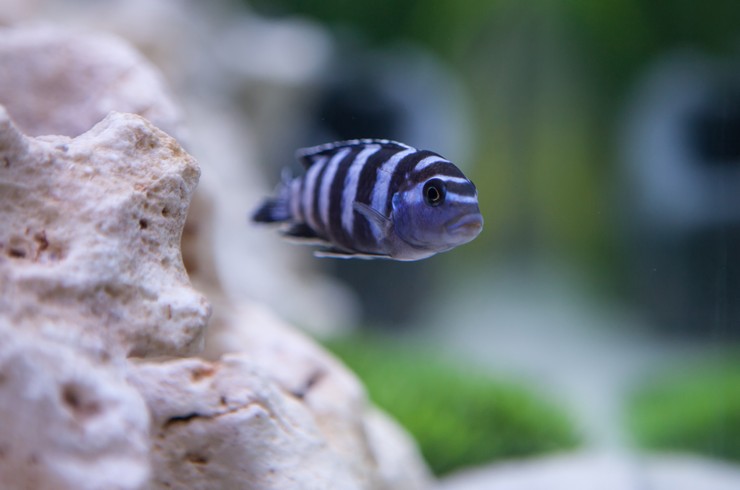
However, the incredibly beautiful coloring of the DeMasoni pseudotrophy and interesting behavior attracts the attention of cichlid lovers around the world. Like other representatives of the Mbuna group, the fish have an interesting way of reproduction – the female incubates eggs in her mouth, and after a while hides the fry in the same place, this increases their chances of survival.
Unfortunately, the natural populations of the fish are under threat, the species is listed in the International Red Book with the “Vulnerable” status. The fish are sold on sale from special farms or from local breeders because it is not at all difficult to get the offspring of the Demasoni pseudotrophy at home.
Appearance
The pseudotropheus Demasoni has a small (6-8 cm) torpedo-like body. A beautiful pattern immediately catches the eye, consisting of contrasting transverse stripes of dark blue (sometimes almost black) and light blue. The stripes partially extend over the dorsal fin, where they narrow and deviate back. The upper part of the head also has three narrow longitudinal stripes, while the lower one is solid blue.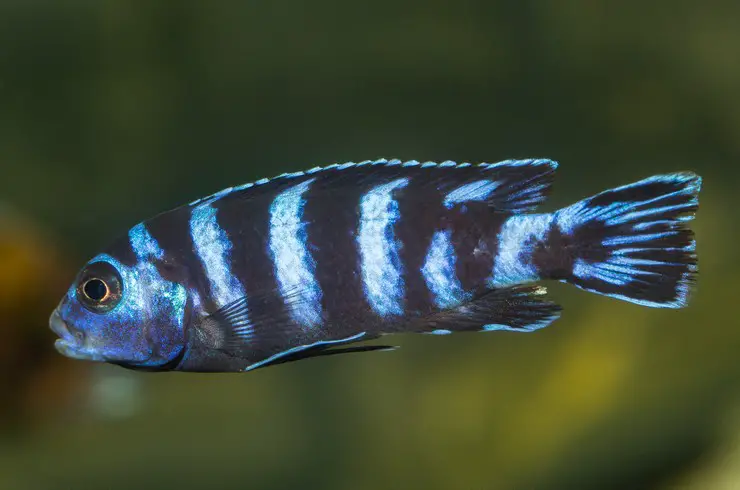
The dorsal fin stretches along the entire back, the anal fin is small, shifted to the caudal. Several orange spots appear on it (most often in males), which help males to fertilize eggs during spawning. The tail is single-lobed, dark blue with blue veins. All fins have a beautiful blue border.
The lips are fleshy, in the mouth, you can see the teeth, which serve as a tool for pseudotrophies to get food.
Habitat
Demasoni pseudotrophies are endemic to Lake Malawi (Nyasa). They inhabit a small area off the coast of Tanzania known as the Pombo Rocks. Cichlids live in shallow water (up to 4 m), practically never occur in open water, spend their whole life near the rocks, which serve as their home and source of food.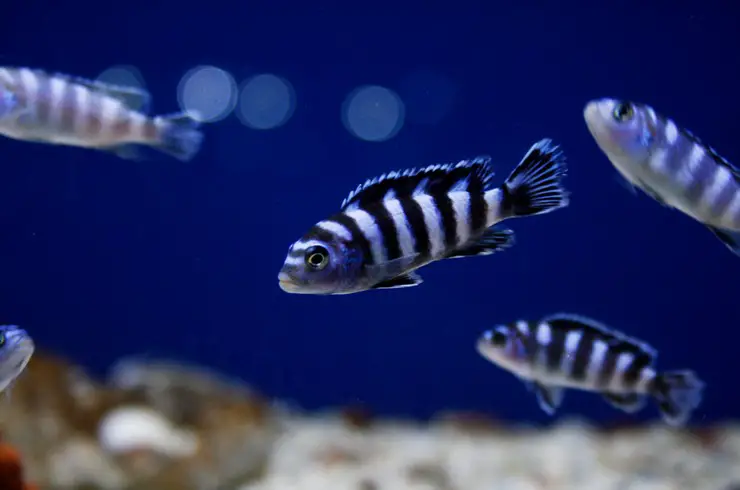
Care and maintenance
Despite its rather modest size, the pseudotrophyus DeMasoni needs a spacious aquarium of 200 liters or more. Usually, the fish are kept either in harems of a male and 3-4 females or in large groups of 10-12 individuals. In flocks of pseudotrophies, a rigid hierarchy is established. The dominant male sometimes attacks his congeners, and here the group content helps to “spray” his aggression a little.
When designing an aquarium, it is recommended to create conditions as close as possible to natural ones. A thick layer of sand or pebbles is laid on the bottom, on which a composition of a large number of stones is created. They must form many crevices and hiding places for females and subdominant males to hide in. In addition, you can put plastic pipes, ceramic pots, coconut halves in the aquarium. DeMasoni pseudotrophies do not require large swimming areas, they spend most of their time near stones. Live plants are usually not used in decoration.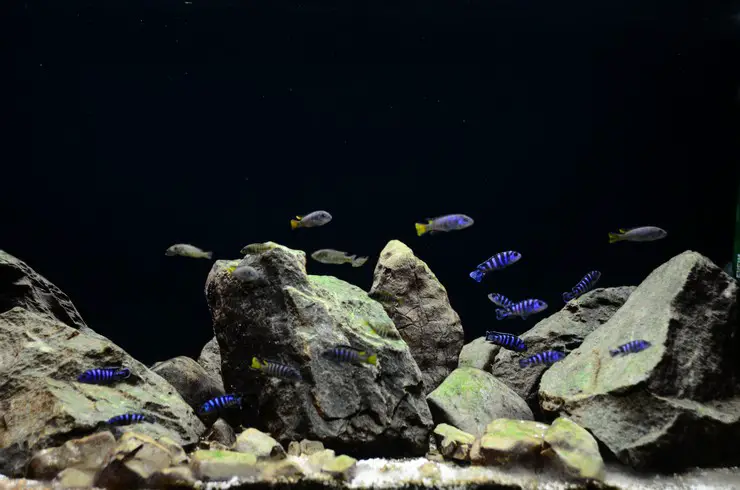
Pseudotrophies are sensitive to water quality, so the aquarium should be equipped with an efficient external filter and a suitable compressor. Install a thermostat of suitable power to maintain a comfortable temperature. Once a week, it is necessary to make a water change (20%), combined with cleaning the soil with a siphon. If tap water is used for changes, then it must be prepared with the Tetra AquaSafe conditioner, which will save you the need to settle the water. Simply add 5 ml for every 10 liters of freshwater, stir gently and pour into the aquarium. The drug will remove chlorine and heavy metals from the water, as well as additional vitamins and useful microelements.
Lake Malawi has a high mineral content due to its tectonic origin, so the water in a pseudotrophy aquarium should be quite hard and alkaline.
Compatibility
Given the increased aggressiveness of the Demasoni pseudotrophies, a species aquarium would be an ideal option for keeping them. You can only combine the fish with other cichlids of the Mbuna group, and it is better to choose species that do not have stripes, for example, labidochromis yellow or red zebra.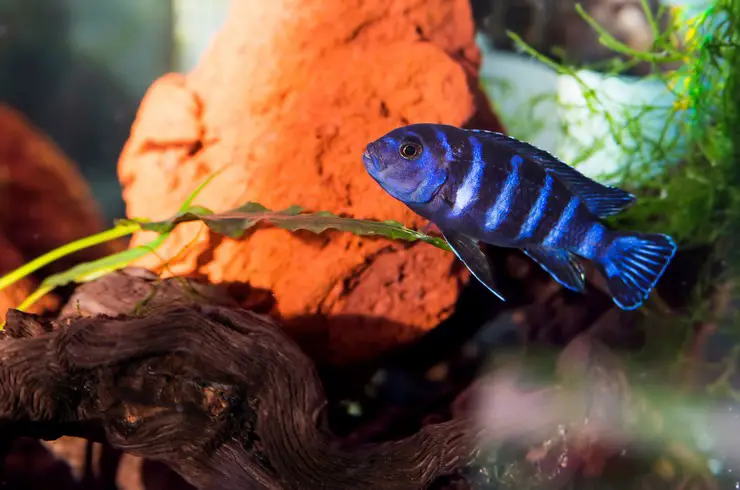
Do not forget that joint maintenance will require an adequate volume of the aquarium and a large number of various shelters.
Feeding the pseudotrophy DeMasoni
The natural diet of the Demasoni pseudotrophyus includes algal growths, as well as various small invertebrates that inhabit them. It follows from this that the main food for this fish is vegetables. Long-term feeding with live or frozen food of animal origin leads to disruption of the digestive system and can lead to the death of fish. Therefore, the best choice will be high-quality dry food with a high plant content.

